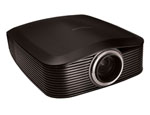
Introduction to the Sony VPL-VW95ES Projector
With the shift from CRTs to flat panel and projection displays, Sony has had to find something to replace the veritable Trinitron that was a symbol of excellence for so many years. Their proprietary version of Liquid Crystal on Silicon, SXRD, has been their high-end technology, appearing in products their Qualia reference line, to the first home 4K projector this year, and in the VPL-VW95ES reviewed here.
SONY VPL-VW95ES PROJECTOR SPECIFICATIONS
- Design: 3-chip SXRD, 1920x1080p 3D Projector
- Inputs: 2x HDMI 1.4a, 1x Component Video
- Light Output: 1,000 Lumens
- Contrast Ratio: 150,000:1 with Iris
- Refresh Rate: 240 Hz
- Control: 12V trigger, Remote In, RS-232
- Zoom: 1.6x Motorized
- Lens Shift: 25% Horizontal, 65% Vertical, Motorized
- Size: 7.1″ H x 18.5″ W x 19.1″ D
- Weight: 26.5 Pounds
- MSRP: $6,999 USD
- Sony
- SECRETS Tags: Sony, Projector, Display
Using their own design has given Sony the ability to come out with features, such as a 240 Hz refresh rate, which other LCoS vendors cannot match at this time. In the VPL-VW95ES projector, Sony has combined their most recent SXRD technology along with high quality electronics and optics to produce a high-end home theater projector that aims for reference quality at a modest price. Does it deliver?
Design and Setup of the Sony VPL-VW95ES Projector
Sony has had a distinctive style for their projectors now that goes back to the Qualia line with a rounded top, curved rear, and side-mounted connections. A small, flip-down door on the right side, just above the inputs, conceals the projector-mounted controls. The input panel has a pair of HDMI inputs, a VGA input for a computer, and a single component video input. There is an RS232 port for control, as well as 3.5mm jacks for IR input and a 12V trigger. There is a pair of 3D glasses with charger inside the box, and the emitter is integrated into the projector itself.

The front of the projector has an automated lens cover that keeps the lens safe from harm while not in use. Behind that lens is a trio of SXRD chips with 1920×1080 resolution as well as a dynamic iris. The lens is fully remote controlled, with zoom, shift, and focus all easily accessible by remote. This also allows Sony to implement a lens memory system for people to use with screens that use an aspect ratio wider than 1.78. Sony also provides for 5 memory locations, which is enough to store all of the most common aspect ratios (1.78, 1.85, 2.20, 2.35, and 2.40) so you don’t need to compromise at all with a wider screen.
Setup of the 95ES was simple thanks to the motorized lens control and remote. While the pixel alignment was a little bit off when I first took it out of the box, there is an alignment system to help clear that up. Should the basic alignment prove to not be enough, there is a 144 zone, very fine pixel alignment system to make sure the image is as sharp as it can be. After using this the uniformity across the screen was very good, with a very sharp image and pixel structure that was visible up close, but disappeared just a couple of feet from the screen.
The setting of lens memories was also quite easy and I had all 5 programmed in no time with the remote. Sony did a nice job with that remote, with good backlighting and quick access to almost every feature on the projector. Individual picture settings were accessible from the remote as were almost all picture settings. The only thing missing from the remote were individual input buttons, as there was a single input button to switch between them. With only three inputs this didn’t prove to be an issue when using the projector. I wound up running the projector in high lamp mode for my screen, but the combination of a lower powered lamp and a well-designed heat dissipation system meant that I really couldn’t notice any extra noise at all. Only during a completely silent section of “Midnight in Paris” did I pick up the fan noise, and my head is 1.5′ from the projector itself.
The Sony VPL-VW95ES Projector In Use

I broke in the Sony by watching the Blu-ray of LA Confidential, which I hadn’t seen in a long time. The Blu-ray has a very nice transfer, with jacket textures that are incredibly detailed, as well as extensive shadow detail in nighttime scenes. Having not had a projector with a dynamic iris in my room before; I wasn’t sure how I would like one. Even as I tried to look for it in use, I didn’t notice any obvious pumping effects or anything else from the iris. With LA Confidential the Sony did a good job bringing out all those textures and not obscuring anything in the shadows during the shootout near the end of the film. Since LA Confidential is a 2.4:1 film, I took advantage of the lens memory on the Sony and it performed quite well. The adjustment was very quick, taking perhaps 10-15 seconds, and lined up well once it was done.

Watching Baraka is always a treat, as I’m not sure that any Blu-ray disc offers a better visual experience. After a calibration, the images produced were truly stunning that came out from the Sony. Contrast was good, and I didn’t notice a pumping of the dynamic iris that could distract. Skin tones were very natural, and there was no loss of detail in any scene. Baraka is one film that can give you that “looking through a window” experience, and the Sony did deliver that.

For 3D, I went with Puss in Boots, which is the wonderful looking new disc from DreamWorks Animation that is stunning in both 2D and 3D. I found that some scenes led to a good amount of interframe (visual) crosstalk (seeing a bit of the left eye frame in the right eye, and vice versa). The depth in scenes was quite good, and the overall level of detail was very good as well, but the ghosting was worse than on a few other projectors I had used. The light output also wasn’t as bright as I would like it to be for a screen of my size. For watching a lot of 3D I would go with a higher gain screen, at least 1.5 or 1.7, and nothing larger than a 100″ 16:9 ratio, to get a bright enough image.

I also went back to watch Cars 2 in 3D again, as it is the material I’m most familiar with and I like how Pixar chooses to use 3D on the film. The sense of depth provided by the Sony was very good, just as it was with Puss in Boots. The main issue again was crosstalk as the eyes of the cars make it easy to see it during the film, and the flyover of Porto Corsa showed a decent amount of artifacts caused by the crosstalk as well. The 95ES was a good 3D projector, but not an excellent one.
Where many people put Sony ahead of other projectors is for their motion handling. Sony has a 240 Hz refresh rate with their SXRD panels, and either their motion interpolation they can produce a smoother, more fluid image than other projectors out there. I wouldn’t use it for movies myself as I like the cadence of film, but for watching football and other sports on the big screen, I think many people will take advantage of it. Watching the Packers-Giants game I keep stored on my TiVo, with the Motion Enhancement on High I didn’t notice any strange, unnatural behavior or movement, but details like yard lines and numbers stayed sharper and less blurred while the camera panned across the field. For sports, it is as good of an image as I’ve seen on a home projector, with fast, clear motion, no visible artifacts beyond the HDTV compression ones, and a very good image.
One area that Sony could improve with their lens position system is adding names to the labels. Right now you only have Position 1 through Position 5. Since I programmed them in a random order, I have 1.78 as Position 1, 2.40 at Position 2, 2.20 at Position 3, and 1.85 at Position 4. Being able to rename, or even reorder, these would make them more useful for people to easily select.
It would also be nice in the future if Sony could put up alignment patterns for popular aspect ratios, or lets you enter a ratio from the remote, so make programing these lens memories much easier. Compared to the other memory systems I had used, the Sony operated much faster and the additional memory positions were very nice to have. As many people are opposed to anamorphic lenses due to the scaling required that can produce artifacts, I hope lens memory is here to stay and keeps improving as time goes on.
The Sony VPL-VW95ES Projector On the Bench
Out of the box, the Sony is reasonably good. The RGB balance for the grayscale was lacking in red, with large errors at the bottom of the grayscale and dE values over 10 that are easily visible. The color points look a bit off but that is only due to the Sony defaulting to the Wide colorspace instead of the normal one. Gamma was low at virtually 2.0, with a large drop off at 90% before coming back up at 100%.


After calibration the grayscale was much better with all of the values being very good except for the 20% value. I chose to use DeltaE UV instead of the more common DeltaE 1976 for the grayscale measurements as that removes luminance from the math, and with grayscale the luminance is handled with gamma. This will lead to larger error numbers, but they will be more accurate. It also prevents the grayscale error from being affected by the gamma controls, in case they don’t interact well.


In the gamma you see an issue at 90%, where the gamma drops significantly for some reason. I found that the 90% gamma issue didn’t occur unless I was using one of the User color presets, but as the other presets don’t allow you to adjust the grayscale it is a compromise I had to accept. If you have an external processor like the Lumagen Radiance, I would use a preset color to get a more linear gamma response. Using the RCP control I was able to get the colors perfectly dialed in, with dE 1994 values below 1 and the luminance was virtually perfect. I also didn’t notice any ill effects on the image from using this, and kept it enabled after doing a lot of A-B comparisons. The 95ES makes it very easy to switch between having RCP enabled and disabled, which is nice.


On the video processing bench, the Sony did well except for the jaggies test, where it looked very bad for some reason. With 3:2 and 2:2 content the pulldown worked perfectly. The Sony also rolled off some chroma detail with 4:2:2 signals, so I would feed it either 4:4:4 or RGB to get the full resolution out of the projector.

With a 96″ 16:9 screen area and a gain of around 1.3, the Sony was giving me close to 16 ftL in low lamp mode, and 23 ftL in high lamp mode after calibration. These come out to around 520 lumens in high lamp mode and 360 lumens in low lamp mode, rated very conservatively. I usually ran in high lamp mode as the projector was still very quiet, and using the zoom method for my 2.40 screen would reduce that light output as well. With the iris disabled in high lamp mode and measuring directly from the lens, I measured an on/off contrast ratio of 7,613:1, and with the iris enabled that number jumped way up to 37,449:1 as you would expect.
Conclusions about the Sony VPL-VW95ES Projector
Liquid Crystal on Silicon (LCoS) continues to be my favorite technology for projectors due to the wonderful film-like image it can put forward. Compared to the JVC LCoS projector I reviewed recently, the Sony is just a little bit behind in native contrast, but helps to make up for that with a dynamic iris that performed well and I couldn’t see in action. Additionally the motion handling was the best that I had seen, and the lens memory system was very well implemented with a CMS that did very well except for that gamma issue at 90%.
The main issue that I had with the 95ES was the 3D performance, which had a bit more interframe crosstalk than I would have liked to see, and was a bit dark. Since I am concerned with 2D image quality ahead of 3D, this really didn’t bother me that much. I’ll gladly take a sharp, accurate 2D image that makes films from the past 100 years look fantastic than trading that performance for a bit brighter 3D image on some recent film full of cheesy effects. If you want to watch a movie with that natural film look, and have a projector that looks just as good when people come over to watch the game, the Sony 95ES will fit the bill.


